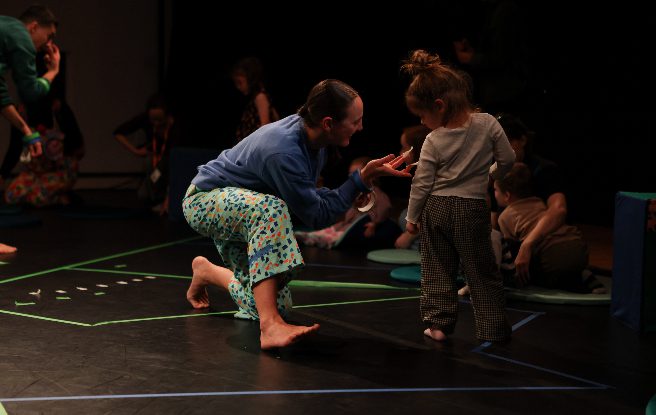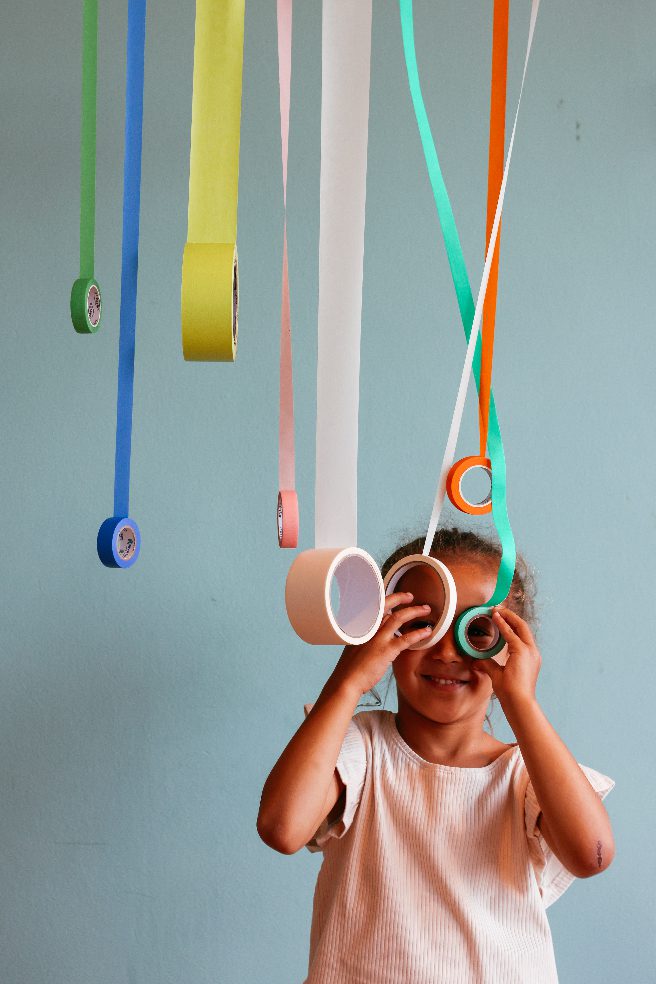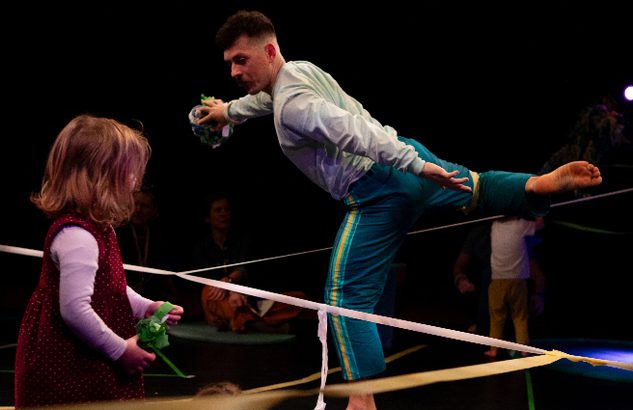Rachna Joshi, a Froebel Travelling Tutor, reflects on how young children learn and experiment through dance - and introduces a new touring dance performance for children and their families.
How often do you dance with the children in your early years setting?
I remember in my first year of teaching, on the day before the summer holidays, we had a small class party. I had run out of games to play, and my Teaching Assistant said to me “dance with your children Rachna”. It was permission to be free, to be with children and move, and express joy and happiness. Since then, dancing, putting music on and moving is my favourite thing to do with young children.
For children, dancing is innate, something that comes over children when they hear a beat or a rhythm. Babies and toddlers moving their limbs as an expression, or standing and bouncing up and down. Children begin copying movements that adults do - clapping, smiling, laughing, twisting and turning.
I was invited to be an audience ambassador for Second Hand Dance, to consult on their new production The Sticky Dance. I really had no idea what to expect at the first rehearsal, but when watching the children become part of the performance, I noticed how engrossed they were, how much they moved, how they copied the dancers or didn’t at all and moved in their own ways. The Sticky Dance is a multi-layered performance, with careful consideration of deeper themes.
Froebel emphasises the role of the adult in the child’s life - not just the parents, but those within the community, highlighting the place and contribution of the individual child within the community.
The Sticky Dance, tours schools and settings as well as theatres and festivals. The production is an open invite to children, schools and families to move in a way that makes sense to them - to be in a place that recognises you and enables you to dance as you please.
...The Sticky Dance widened my understanding of expression, creativity and dancing with children...
Autonomy and freedom
One of the first themes, that chimes with Froebelian principles, is the belief that children should be autonomous. Within the performance, the dancers invite children to come and dance with them, the music guiding the energy of the dance. Children were given choices - come and dance, or don’t dance and stay close to a familiar adult - we understand that it can be challenging in an unfamiliar place.
The dancers used sticky tape - this symbolised boundaries, and throughout the dance the sticky tape was laid on the floor, on the structures, on the adults and children, then peeled off and destroyed. The sticky tape acts as an invitation or a ‘role’ for the parents and educators to play - something that provides comfort and a ‘job’ for many who are not as inhibited as the children are.
The music and the energy provided the guidelines for the performance - creating pace, rhythm and changing the concepts of time. The symbolism of creating rules and breaking rules, using dance as a medium to express how we move through these boundaries and rules - making sense of them as we move, summarises themes of autonomy and freedom behind The Sticky Dance.
Even in the logistics of The Sticky Dance the rules were broken, by removing the start and finish times, children and families in the performance are welcome to enter the performance and leave as they wish. The dancers ran through the dance twice, so no one missed anything out - an emblem of fairness incorporated into the details of the performance.
Also, I use the word ‘performance’ because there isn’t quite a word to define what The Sticky Dance is, an installation, interactive dance or participatory performance? When discussing with the producers - Rosie and Takeshi, we couldn’t find the word that labels what this is: A moment in space and time where there are no rules and boundaries and you can come as you are to express yourself with your body in any way that you feel.
Children were learning about dance, about how this space offers a way to communicate, imitate and respond to music.
Is it play?
Throughout the discussions I had, we explored whether this was a space for children to play - were children playing or dancing? And what was the difference? The conversations brought up the 12 features of play by Professor Tina Bruce - were there some features present during the performance?
For many children, they would be drawing on some previous experience of dance and movement, but to do it in this way with music, stage and dancers would be a new experience - therefore not necessarily a space to play. Children were learning about dance, about how this space offers a way to communicate, imitate and respond to music.
However, there is a sense of transformation within the performance; a wholeness and sense of fulfilment of being part of this wonderful dance. You leave feeling that you have heightened your senses, and developed a sense of creativity and openness that didn’t exist in the same way before.
I felt curious about movement and dance, but The Sticky Dance widened my understanding of expression, creativity and dancing with children.

Role of the ‘educator’
The final theme linked to Froebelian principles was the role of the educator - in this case, the parents and carers who brought their children to the rehearsal I observed, and the dancers. I noticed how the interactions between the dancers and the children were so nuanced and intuitive. I don’t know whether the dancers had experience working with children - but their interactions through movement were so subtle, open and inviting. They demonstrated such a deep understanding of children’s boundaries and consent, they modelled to children the different moves, and also imitated what the children offered - a conversation of movement and dance. The parents and carers represented a home base for the children to return to when they became overwhelmed or needed a break, some parents got up and danced with their child too, some also met with other families and created new connections and communities within the space and time of the performance - and perhaps extending to outside of the performance.
-
See The Sticky Dance on tour
17 May 2024
10:00am & 2:00pm & 3:15pm
@ Brighton Festival
(Afternoon performances are Sensory Adapted and suitable for neurodivergent audiences)
24 May & 25 May 2024
10:00am & 2:00pm
@ Spark Festival in Leicester
18 August 2024
@ MAC in Brimingham
25 August 2024
@ bOing! festival in Canterbury
Plus more performance dates to be announced soon

References and free resources
Watch the Froebel Trust 2023 Annual Lecture with the award winning dancers and performers, Anthony and Kel Matsena
Download a free copy of Empowering Learning: play, symbols and creativity by Professor Tina Bruce - part of the Froebel Trust pamphlet series
Bruce T., (2021) Friedrich Froebel: A critical introduction to key themes and debates, Bloomsbury
Download a free Froebelian Principles poster for your school or setting
Download a free copy of Songs, rhymes and finger plays by Jane Dyke - part of the Froebel Trust pamphlet series
About the author
Rachna Joshi is a Froebel Travelling Tutor - bringing the Froebel Trust Short Courses to early years settings and schools across the UK.

Rachna is an early childhood teacher, action-researcher and consultant. She works with under-threes, Nursery and Reception children in classroom settings and holds an MA in Early Childhood Studies. Rachna also writes for organisations like Tapestry and Early Education. Her recent work includes embedding music into settings via grants to purchase outdoor music walls, open-ended music resources and workshops for children and their families.
You can read another of Rachna's articles: Sing and move, love and belong (published by the Froebel Trust in 2022)


